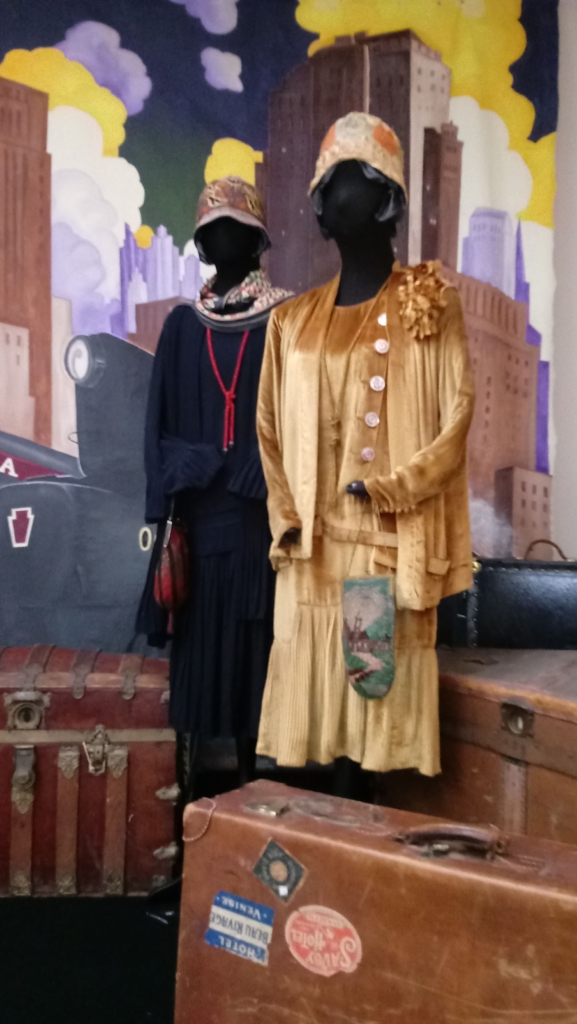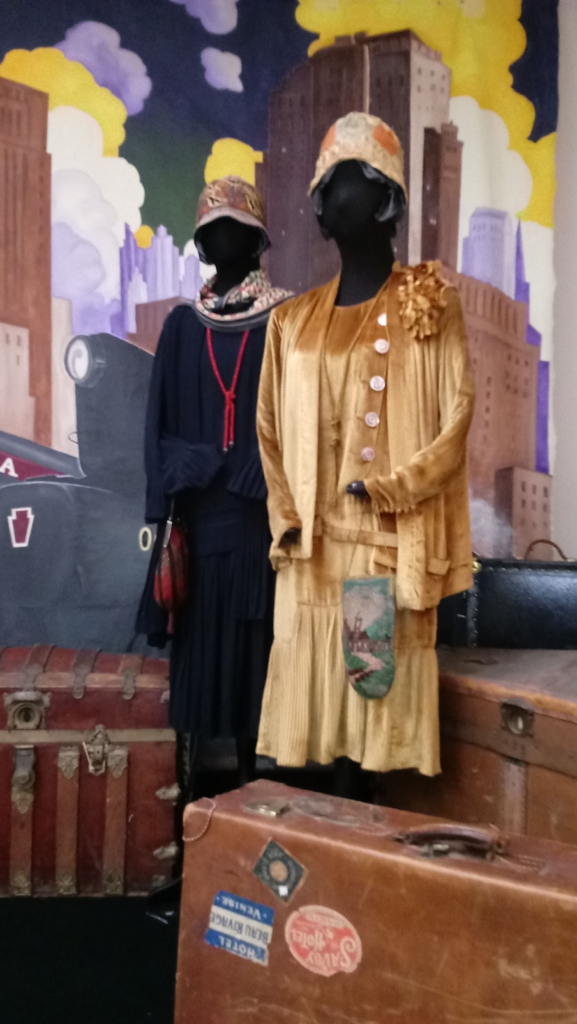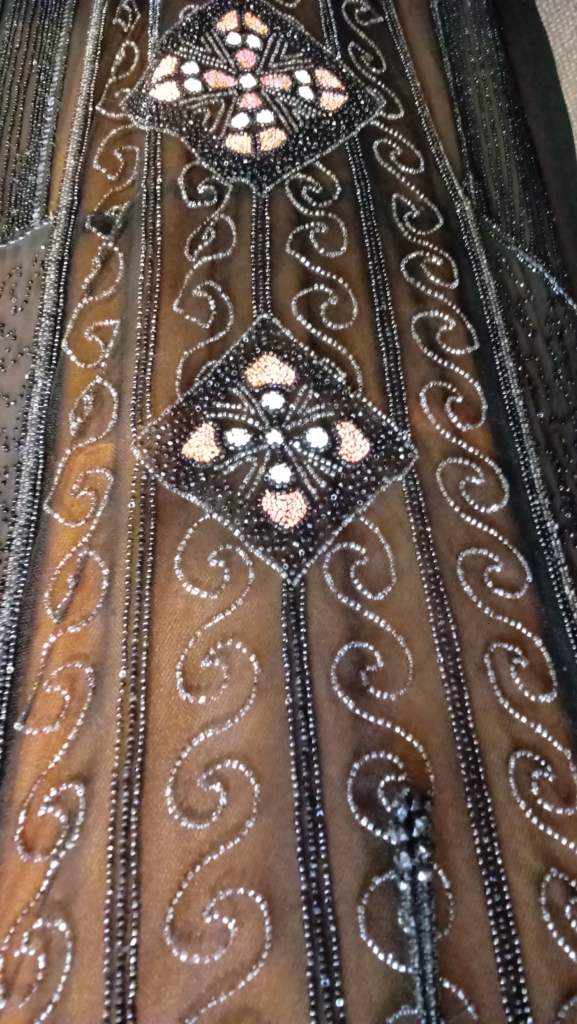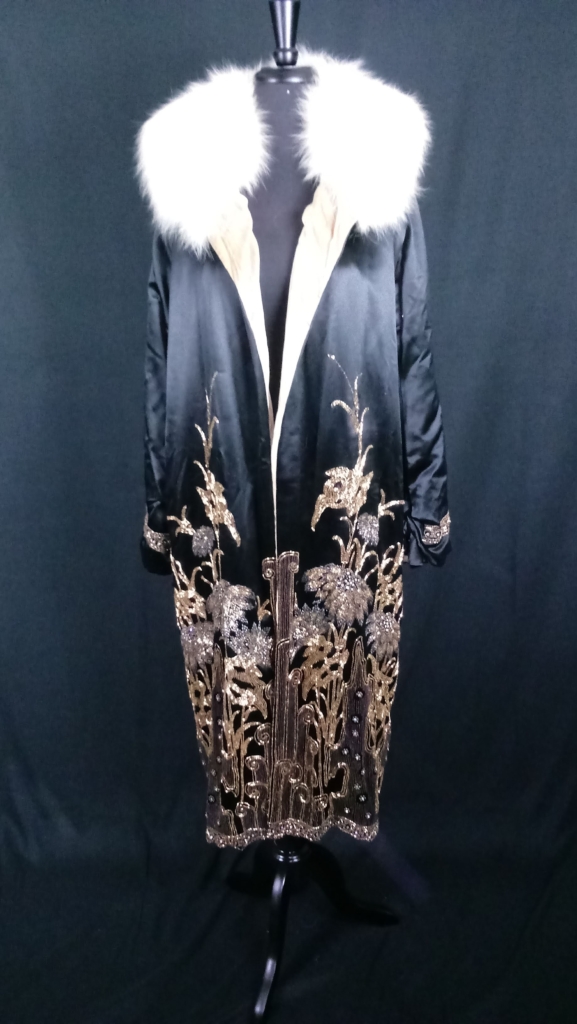Worn to Dance: A 1920s Fashion and Beading Exhibit at Lacis Museum of Lace and Textiles

By Kij Greenwood

Buckle up your dancing shoes and throw away your cares, because the Twenties are coming back around!
Almost one hundred years ago, the Jazz Age saw dramatic social change in America. A new generation of women was, for the first time ever, voting, driving, spending their own money, smoking and drinking in public, bobbing their long hair, showing off their calves, even dispensing with their corsets. And–perhaps most thrilling of all these new liberties–they could sample the nightlife and go out dancing.
As an unintended result of the Prohibition, modern women were exploring whole new social territory: the intimate, smoky world of nightclubs and speakeasies. No wonder the primary pastime of the ‘20s is remembered as dancing to the rhythms of Hot Jazz. That novel and exhilarating music will forever evoke the image of a woman in her fashionably shortened dress, with its radically simple, shift-shaped silhouette sparkling with so many hours’ worth of intricate beadwork.

The decade of the 1920s provided a radical change in fashion silhouette. The period from 1900 to 1920 formed a bridge between the extreme hourglass silhouette of the 19th century and the simplified verticality of the Jazz Age. The Edwardian period, from the early 1900s to the end of World War I still cinched and contoured women into shape by corsetry. The silhouette of the time emphasized a full breast and only slightly diminished the hourglass of the hips. In the 1920s, the desired silhouette was whittled down to the refreshingly simplified and plain, columnar shape showcasing boyish athleticism and youth over mature proportions. And while Edwardian clothing was renowned for its ornate beaded embellishment, the flapper style evening dress was far less restrictive, built, in fact, to facilitate the riotous and revolutionary movement of animated dancing. These dresses were designed to make a statement, capitalizing on all the glitter, weight and movement that beadwork, as a medium, has to lend.

A wide variety of beads were used to interpret and reconstruct these styles. Precious stones, metals and other natural elements were being imitated by new materials. Czech glass beads were able to capture a sparkle close to that of precious gems and were produced in colors that mimicked them–particularly ruby, carnelian and turquoise. Japanese markets sold pearls cultivated using new methods. Bakelite was used in many contexts, from industrial applications to domestic settings, which included jewelry and beads. These plastic beads often imitated other precious materials, like ivory, jet or amber, making opulence available to the everywoman.

The discovery of Tutankhamen’s tomb in 1922 sparked the imagination and ignited a craze for all the things of “Oriental” (Asian and Near East) origin. The fad manifested itself everywhere across the applied arts, and a large proportion of beaded motifs on dresses and jewelry were meant to evoke an Ancient Egyptian and Grecian style. There are several examples of these motifs in this exhibit.
One of the most popular techniques for both embroidery and bead embellishment is “Tambour.” While tambour work has its origins in ancient Chinese Textile arts, The word “Tambour” however, comes from the French for “drum” (which compares the tambour-work cloth, held taut within a supporting structure, to the percussive musical instrument). Tambour work is performed with an eyeless needle, fixed to a handle. The needle has a piercing point, but it also features a miniscule hook. The fabric is tightly and securely stretched within the supporting structure of the frame, leaving space above and below to work the stitches and apply the beads or sequins. The procedure relies on the chain stitch and that is how it can be identified as tambour work.
In the 1920s a wide variety of materials were used in creating beautiful beaded gowns. Textiles ranging from silk organza and satin to silk velvet were divided into two panels. These panels would then be stretched onto frames and adorned in designs shaped to suit the cut of a dress. Though some dresses were beaded with a simple needle and thread, it is the tambour technique that was most-commonly used. After the designs were fully beaded they would then cut the dress shape from the panel to be assembled into stunning gowns.

Just like today, a wide range of 1920s clothing was available at different price points. The elite could wear one-of-a kind haute couture beaded and sequined dresses, designed expressly for them by high fashion ateliers, tailored to their specific size and hand-embroidered and embellished by skilled artisans. The middle-class consumer was more likely to buy a machine-beaded dress “semi-made” at a department store and have it finished to their size.

Alternatively, the budget-conscious fashion enthusiast could bead her own dress, employing the patterns published in women’s magazines of the day. Prolific needlework author and educator Mary Brooks Picken developed the classic 1920s “One Hour Dress” method for just such a home seamstress. By following her instructions, which remain in print and popular to this day as a recent Lacis workshop could attest to, women could readily make–and customize–their own fashionable, flapper-style dresses.

These dresses, like the Jazz Age itself, were not built to last. The weight of the beads continually drags on the fragile silk holding them together and makes their eventual collapse inevitable. This is why, though the dresses are iconic, so few of them remain today. Our staff members (including GBACG members Lynne Taylor and myself) have worked countless hours to stabilize and preserve the stunning dresses in our collection so that we could share them with you. We urge you to join us in remembering the fun, freedom and decadence of the Jazz Age as we celebrate the artistry of these beautiful dresses.
The Lacis Museum of Lace and Textiles (LMLT) in Berkeley is a unique local museum whose purpose is:
- to preserve lace and textiles of all cultures from all periods.
- to provide a resource center for research and documentation of these objects.
- to educate and disseminate knowledge of lace and textiles.
While the exhibit galleries for LMLT are not currently open, the Lacis shop is open for curbside pickup and shopping by appointment. Once we are open for exhibits again, tours will be by appointment, Monday through Saturday, and will be scheduled for 1:00 p.m., 3:00 p.m. and 4:30 p.m. Admission is $3.00 per person but free to LMLT members. Group rates are available. Please call Lacis at 510-843-7290 during regular business hours (Mon.-Fri., Noon-6:00 p.m.) or by email to info@LacisMuseum.org.

Pingback: Unraveling the Mystique: The Enigmatic Connection Between Gothic Witches and Metal Bead Necklaces – Sweetandspark